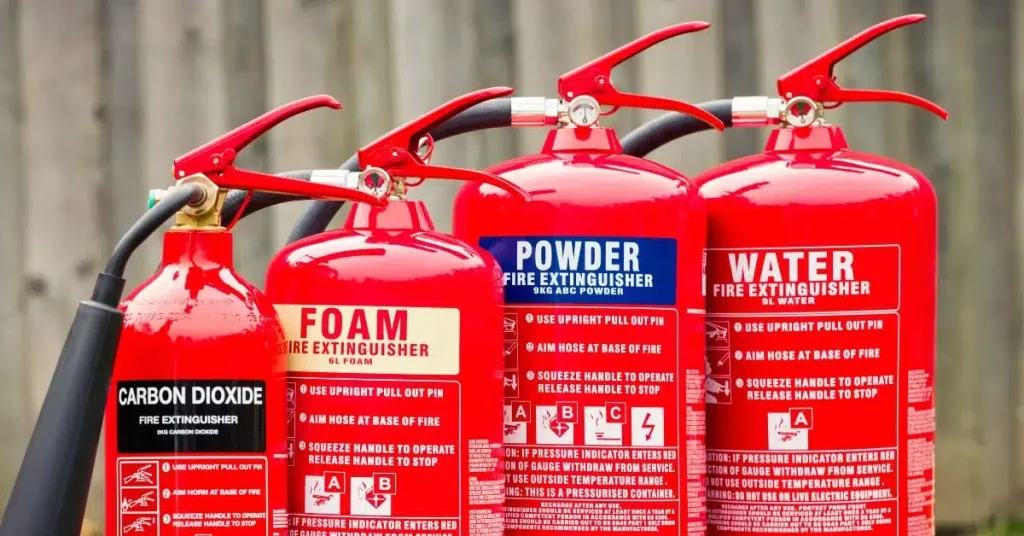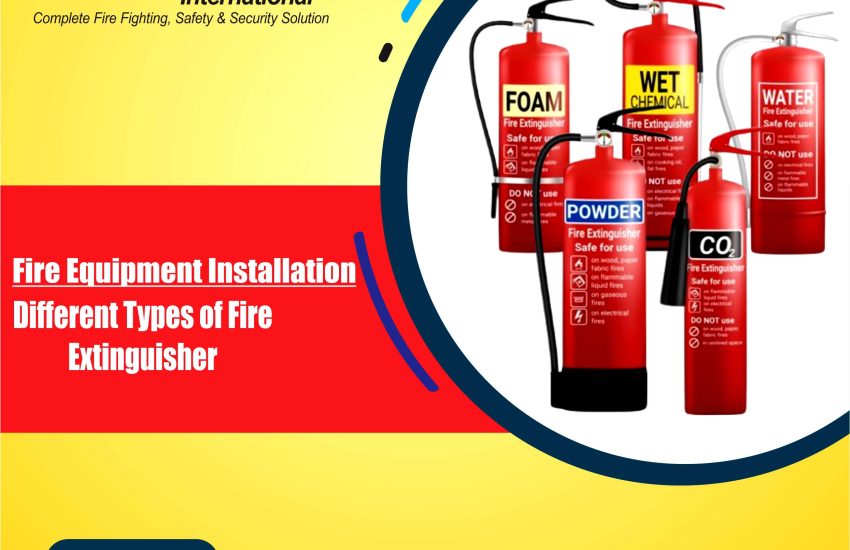Different Types of Fire Extinguisher Understanding the different types of fire extinguishers is crucial for ensuring safety in both domestic and commercial settings. Fire extinguishers act as the first line of defense against small fires, and using the correct one can prevent a fire from spreading. In turn, this can save lives and property. Each type of extinguisher targets specific fire classes, and using the wrong one can be ineffective or dangerous.
Fire Extinguisher Types

Different Types of Fire Extinguisher Knowing the different types of fire extinguishers is essential for responding effectively to a variety of fire emergencies. Each extinguisher is designed for specific fire classes and scenarios, so it is vital to choose the correct one.
1. Water Extinguishers
- Description: Water extinguishers are the most common type. They are suitable for Class A fires involving solid combustibles like wood, paper, and textiles.
- Color Code: Bright red.
- Use Cases: These extinguishers work well in offices, schools, and homes with general combustible materials.
- Not to Use On: Avoid using water extinguishers for electrical fires, kitchen fires involving oils and fats, or fires involving flammable liquids and gases.
2. Foam Extinguishers
- Description: Foam extinguishers are versatile and effective on both Class A and B fires. They can handle fires involving liquids like petrol, paints, and fats.
- Color Code: Cream.
- Use Cases: They are ideal for workshops, garages, and areas where flammable liquids are present.
- Not to Use On: Never use foam extinguishers for kitchen fires involving cooking oil or electrical fires unless dielectric-tested.
3. CO2 Extinguishers
- Description: CO2 extinguishers are designed for electrical fires. They also work on Class B fires, such as those involving flammable liquids.
- Color Code: Black.
- Use Cases: These extinguishers are particularly useful in offices and spaces filled with electrical equipment, such as server rooms.
- Not to Use On: Do not use CO2 extinguishers for Class A fires, cooking oil fires, or fires involving flammable metals.
4. Powder Extinguishers
- Description: Powder extinguishers, also known as ABC extinguishers, are effective on Class A, B, and C fires, making them suitable for a wide range of fire risks.
- Color Code: Blue.
- Use Cases: They are ideal for vehicles, boats, and locations where multiple types of fire hazards exist.
- Not to Use On: Avoid using powder extinguishers indoors unless absolutely necessary. The powder can obscure visibility and may damage electrical equipment.
5. Water Mist Extinguishers
- Description: Water mist extinguishers use fine water spray particles to fight various fires, including Class A, B, C, and some electrical fires.
- Color Code: White.
- Use Cases: These extinguishers are perfect for areas where other extinguishers might leave harmful residue.
- Not to Use On: Water mist extinguishers are generally safe for most fires, but their effectiveness can vary. Always check the manufacturer’s guidelines before use.
6. Wet Chemical Extinguishers
- Description: Wet chemical extinguishers are specifically designed for Class F fires involving cooking oils and fats. They are also effective on Class A fires.
- Color Code: Yellow.
- Use Cases: These extinguishers are vital in commercial kitchens and food processing areas.
- Not to Use On: Wet chemical extinguishers should never be used on flammable liquid or gas fires or fires involving electrical equipment.
How to Use Fire Extinguishers
Knowing how to use a fire extinguisher properly is essential to controlling a fire before it spreads. Follow these steps to ensure you use the extinguisher safely and effectively.
1. Assess the Situation
Before acting, assess the situation to ensure the fire is small, contained, and not spreading. Always make sure that your escape route is clear and safe.
2. Alert Others
It is crucial to raise the alarm immediately to inform others in the area. Ensure that everyone evacuates the building, and call the fire department, even if you think you can manage the fire yourself.
Step-by-Step Guide on Using Extinguishers (P.A.S.S. Technique)
- Pull: Pull the pin at the top of the extinguisher to break the tamper seal.
- Aim: Aim the nozzle or hose at the base of the fire from a safe distance.
- Squeeze: Squeeze the handle to release the extinguishing agent.
- Sweep: Sweep the nozzle from side to side at the base of the fire until it seems to be out.
When Not to Use a Fire Extinguisher
In certain circumstances, using a fire extinguisher may not be the safest option. Here are some scenarios when you should avoid using one.
Do Not Use If:
- The fire is too large or spreading uncontrollably.
- The area is filled with smoke.
- You are unsure which type of extinguisher to use.
- Your escape route is blocked.
Evacuation Over Extinguisher Use
Always prioritize evacuation over trying to fight a fire. If the fire is beyond control or the extinguisher proves ineffective, leave the building immediately.
Fire Extinguisher Maintenance and Inspection
Fire extinguishers require regular maintenance and inspection to ensure they function properly in an emergency. Here’s what you need to know to keep them in good working order.
How Often and Why Extinguishers Need Servicing
Fire extinguishers must be serviced at least once a year by a qualified professional. Regular servicing guarantees that the extinguisher will function properly in case of an emergency.
Who Should Perform Inspections and Maintenance?
Only qualified professionals should handle servicing and maintenance. Additionally, a responsible person should conduct visual checks every month to spot any obvious damage or tampering.
Signs That an Extinguisher Needs Servicing or Replacement
- Physical Damage: Look for dents, rust, or leaks.
- Pressure Gauge: If the needle is outside the green zone, it could indicate overcharging or undercharging.
- Broken Seals: A broken or missing tamper seal or safety pin means the extinguisher may be compromised.
- Expired: Check if the extinguisher has exceeded its recommended lifespan.
Responsibilities of Business Owners and Premises Managers
Business owners and premises managers play a critical role in fire safety. Here are the essential responsibilities they must manage.
Risk Assessment
It is essential to conduct and document fire risk assessments regularly. This ensures that the correct type and number of fire extinguishers are available for each area of the premises.
Training
Owners and managers must ensure that all employees are trained in fire safety, particularly how to use fire extinguishers and the building’s evacuation procedures.
Maintenance
They must schedule regular professional servicing of fire extinguishers and ensure that monthly visual checks are conducted.
Recent Advancements in Fire Extinguisher Technology
The technology behind fire extinguishers continues to evolve. Here are some of the latest developments.
Smart Extinguishers
Many new fire extinguishers now integrate with building management systems, providing real-time alerts and monitoring.
Eco-Friendly Agents
As part of growing environmental awareness, manufacturers are developing more eco-friendly extinguishing agents to replace harmful chemicals.
Recycling and Green Manufacturing
Efforts to recycle old extinguishers and reduce the carbon footprint during production are increasingly common in the industry.
Future Predictions for Fire Safety Equipment
As technology continues to improve, fire safety equipment will become even more efficient. Here are some predictions for the future.
Advanced Monitoring and IoT Integration
Sensors and IoT technology will increasingly be used for real-time monitoring. This will enable faster response times in emergencies.
Comprehensive Safety Solutions
Expect more integrated solutions that combine fire prevention and suppression techniques, offering more comprehensive safety coverage.
Conclusion
Different Types of Fire Extinguisher Choosing the right fire extinguisher is vital for maintaining safety in any environment. By understanding the different types of extinguishers, knowing how to use them, and keeping them properly maintained, you can significantly improve your preparedness for fire emergencies. In addition, staying informed about new technologies and adhering to safety regulations will help ensure that your workplace or home remains safe.


